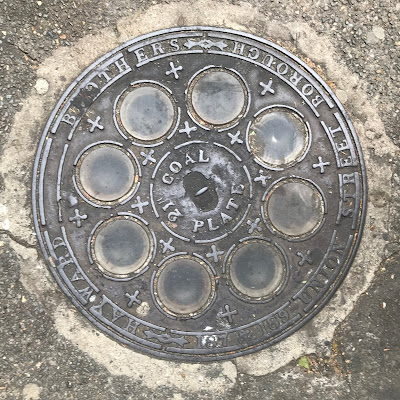I popped in to St James's Hotel and Club yesterday afternoon to have a chat with Graham, the head concierge. We swopped stories and observations about London's quirks and unusual details and he asked me whether the lamp in adjacent Blue Ball Yard was a still powered by gas. Hmm. I didn't know, so I went to check it out.
I'd done a lot of research on gas lamps last year when planning my walking tours on the subject, so it was strange how I'd not previously investigated this particular little enclave of streets between St James's Street and the park.
Blue Ball Yard* today gives access to the rear of The Stafford Hotel's American Bar and, yes, the wall-mounted lamp at the left side is indeed a functioning gas lantern. There is another one at the far end but it is hard to access so I'm not sure if that one too is also powered by gas. See the google streetview here.
It occurred to me that there surely must be other gas lamps in the vicinity. A logical idea, being as St James's Palace, The Mall, Carlton Terrace and St James's Park were all mostly lit by gas during the reign of George IV, so it follows that the well-to-do streets here would also be similarly illuminated.
I ventured into St James's Place, the next street down, and immediately found another wall-mounted lamp on the left of the street at No.44 and two more opposite at No2 and No8 (the green plaque commemorates Sir Francis Chichester) with a similar lantern down the turning to the left that leads to the Duke Hotel and a tall standard lamp at the end of the yard. On the left side there's also a row of low level lanterns that appear to have been completely disconnected.
More tall standard lamps can be found at the western end of the main street. most of which marked GeorgeV 1910. I'm surprised they aren't older being as others in the St James's area date from the reign of George IV.
I counted eleven gas-powered street lamps in St James's Place and this doesn't include those on privately-owned buildings such as the impressive pair outside Spencer House or the one above the door of the Royal Ocean Racing Club, shown below centre.
I also found some other interesting oddities along the road. For instance, there are only a few coal hole cover plates. All of them sport geometric patterns rather than overt branding although some bear the name Mason, see below left .
There is a bizarre circular cover plate near the lamp at No.45 with brass letters bearing the name of F. Devereux, silversmith, who, I am assuming lived/worked there. These discs usually show the name of the foundry/ironmonger who made/sold the plate. I've looked in old directories but I can't see anyone by the name of Devereux here. Instead, the address is listed as a lodging house in 1882 through to at least 1915 when it's shown as apartments. Any ideas?
At the far corner, at No 26 there is a twentieth century building that you could say looks out of place with the rest of the street. It's not an office block but a
Grade II* luxury apartment building designed by Sir Denys Lasdun and constructed 1959-60. It sports a RIBA architecture award plaque (that I forgot to photograph) but what I particularly like about it is the zeitgeist 1950s typeface used on some of the signage – it's very
Univers Condensed Bold Italic.
Back to the street furniture and metalwork... just before the entrance to The Stafford Hotel, almost underneath one of the wall-mounted gas lanterns, is a rectangular man hole cover. If you've read my previous posts about this kind of thing you are probably ahead of me here in guessing that this contains twelve little squares of wood block paving, see above right which I'll add with better photos to my next group of wood block findings in another post soon (ooh the excitement!).
Finally, at the far end of the street, there is a little alley off to the right that leads to the rear gate of the St James's Hotel, the building in which I had started this mini-journey. The sunlight on the buildings yesterday afternoon was amazing, making it look more like somewhere in Italy.
*Blue Ball Yard – I'd been mis-calling it Blue Bell Yard ever since yesterday. I originally thought it was ref to a flower or a hanging bell that with a clapper that was coloured blue. But no, it's a ball. But what blue ball? Is it a game? Was it a sign for something? There are other Blue Ball pubs in the UK, but I have yet to find out the significance of the name. And Cabbie Blog in this link also gets his bells and balls confused. Incidentally, if you haven't already read his book about his life and observations doing The Knowledge and driving customers around London, I wholeheartedly recommend it.
























